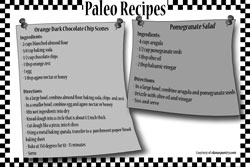We are bombarded with images of weight loss through new diets and fitness techniques all the time, try this try that. Some include the Atkins diet, South Beach diet, P90X, and Cross Fit just to name a few. These established plans have all been targeted to the same audience of people constantly struggling to get the body they’ve always wanted.
There is a new diet, however, making a buzz among these groups. The paleo diet, founded by PH. D Loren Cordain, was actually published in 2002, but has only just recently gained popularity.
The diet gets its name from the paleolithic time period and is essentially channeling the times of hunting and gathering. It is not literally hunting and gathering, but it is similar to the food groups that were being consumed during the prehistoric times. This means foods like meats, fish, leafy greens, nuts, vegetables, eggs and seeds.
There have been arguments against the Paleo Diet for its tight restrictions.
Completely cutting out grains is one strict part of the diet that has come under attack, as the government recommends six to 11 servings per day. However, one of the key persuasions of the diet is that during caveman times, grains were not part of daily intake.
According to a blog on nerdfitness.com, the diet argues that society’s excessive carb consumption is why we are overweight. Altough many nutrition professionals recognize carbs as necessary for an energy source, part of the diet’s marketing ploy is that you actually don’t need carbs for energy. Instead, your body will burn already existing fat. Besides, carbohydrates come from paleo-friendly foods like vegetables and fruits too.
Director of Health Services Kathy Maloney said, “The recommendation is to eat from all of the food groups as outlined in www.myfoodpyramid.gov. The paleo diet covers vegetables and fruits (carbs), nuts (carbs and protein) and meats (protein). It is missing dairy and starches. A person would have to get their calcium from another means and provide enough carbs via fruits and vegetables for energy so that the body does not have to break down proteins for energy.”
Another restriction of the paleo diet is the sugar consumption. The diet forbids eating unnecessary sugar unless it comes from fruit. This means no grains, dairy, or sugar and absolutely no processed foods.
Although there are many restrictions, there are tons of recipes that stick to the diet’s guidelines. Using ingredients like almond flour, honey, and coconut or macadamia oil, you can even make paleo-friendly desserts.
You may not have thought you could have chocolate cupcakes on the diet, but it is possible. With coconut flour, coconut oil, and cacao powder as a few of the ingredients, you can create a gluten and grain-free snack. For more paleo-friendly recipes, check out elanaspantry.com.
With new diets, people are always skeptical of losing the weight and then putting it back on once they see results. However, the paleo diet isn’t just about weight loss. The Huffington Post states that it lowers the risk of cardiovascular disease and blood pressure, can reduce acne and promote optimum health as well as athletic performance.
Still, some of the claims have come under fire by weight loss specialists. One of the main arguments against the diet is that during the Stone Age, when people ate like this, the average life span was only 25 years.
Junior English major Ariana Tepedino, who heard of the diet through a doctor that specializes in herbal remedies, is a supporter of the diet.
Tepedino said, “I’ve lost about 10 pounds since I’ve been on it but I modify it to fit my daily needs so it’s actually not as effective as it could be. Ultimately it’s a hard adjustment but it’s definitely a healthier way of living and it’s worth it.”
Since the paleo diet is so precise, it can be a rocky transition for those starting out. It would be particularly difficult for college students who rely heavily on campus food services.
It’s possible to experience the yo-yo dieting effect of losing weight and putting it back on if not committed. The paleo way is a lifestyle change for those committed to a healthier body.
Tepedino said, “The diet works, as long as you’re diligent with it, and it can be difficult to stick with just because you do have to cut out major food groups like carbohydrates and dairy. At times when you’re rushing you can’t just make a quick sandwich or eat a slice of pizza, you have to make an intricate meal and avoid all the prohibited foods.”
Like any diet, there are pros and cons and advocates and opponents. It has proven to demonstrate weight loss results, so if you’re looking to drop some pounds keep the diet in mind. It’s a drastic change, but perhaps feeding your inner caveman while cutting out the grains and carbs will be worth it.



